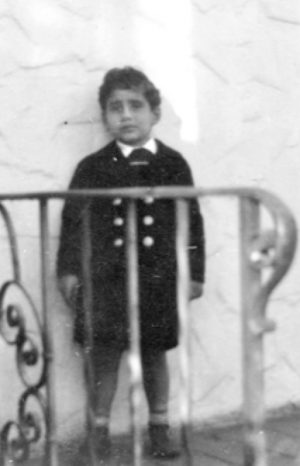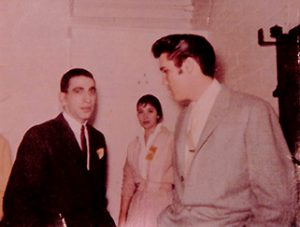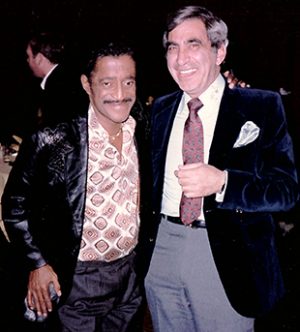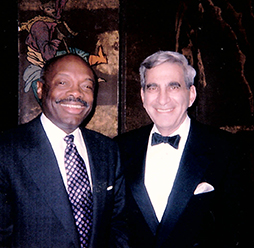Abe Battat: “As long as I had my instrument under my fingers, I was happy.”
by Alex Walsh
When Abe Battat got out of the army, he was convinced he was going to be a musical director for a variety show. So he went to New York and made the rounds at all the TV networks. Nothing happened. Just as the weather was getting bad, he got a call from an up and coming comic he had met in the army, Paul Desmond. Paul was a first-call comedian in the booming club circuit in San Francisco, and he needed an accompanist.
Abe returned home and began his life as a professional musician. He also returned to SF State to finish his degree. “That was the key to the whole thing. My parents didn’t mind me living at home until I was 26, because you can’t just get a job right away. I think parents are important. Your parents have to support you in what you want to do.”

A native San Franciscan, Abe grew up on Sloat Boulevard, across the street from Stern Grove, where he says wonderful orchestras and operas played every Sunday during the summer (and still do). And all free to the public. His father was in the shipping business and his mother was a housewife. His parents were not musical, but all of his siblings were. They did not become musicians, although Abe says they tried. “The music business is not for everyone. I think it requires a certain temperament because you have to stay calm during adverse times. There are people that aren’t musicians running the clubs, and you have to be able to put up with the fat guys with the cigars and gold chains, as I refer to them.”
Abe started piano lessons when he was six. He continued with music through high school at Lincoln High and then SF State. Then he was drafted in his second year. “I went through basic infantry training, and through a series of circumstances, they needed someone to play for a show, and I could do that. And because I could do that, I got into Special Services, which included entertainers and athletes.”
Based in Paris, the band would rehearse for a week with the top stars of the day, and travel around Europe doing shows at different military bases. “I was thrown into this band of musicians who were all experienced, and even though they were just kids, they had already worked with big name bands. They were kind of stuck with me, so they taught me for two years, every day, about playing popular music and jazz.” In his off hours, Abe would hang out at jam sessions on the left bank. It helped that he took French in high school.
“I remember the phone rang one day in the office and a voice said: ‘This is Bob Hope and I’m in Europe. I’m going to stop over in Paris on my way back. If you have a job for me, just give me a call.’ So we got the big opera hall in Paris and trucked in busloads of GIs, and he entertained them. That was a lot of fun.”

Abe was released from the army in 1955. When he got back to San Francisco, the first thing he did was join Local 6. “It was just a kick to be able to say I was a professional musician when people asked me. I joined the union and I met guys around town. I was so naïve about work. When I was a kid I thought, ‘I’m going to be a musician, and I’m going to get a job and go to work every day, just like everyone else has a job and goes to work every day.’ It’s not quite like that.”
Abe was shocked to find there were two unions, a white union, and a black union. At this time, black musicians were not allowed to play east of Van Ness Ave. “I took the elevator to the third floor instead of the 2nd floor. The 3rd floor was the black union. They said, ‘Hey buddy, I think you ought to be down a floor.’ Although I was aware of what was happening in the southern states, I was ashamed that this could happen in my home town. I decided to volunteer for the campaign to elect JFK, who promised to put an end to this stupidity.” The two locals were finally joined in 1960.
San Francisco was buzzing with entertainment at this time. “You wouldn’t believe how much was going on here. There was something called “club dates” which included a pianist, a boy singer, a girl singer, and a comedian. In fact, the singers had the same charts, just written in their different keys. The money was good, it was just a walk in. It was easy. Sometimes we’d just play the Star Spangled Banner with a singer to open a convention. Stuff like that never happens anymore. Every hotel had a band. There were 12 bands working every night just in Chinatown.”

Abe continued working every date he could, including conventions and playing intermissions at the famous Blackhawk jazz club. During this time he finished his degree at SF State. He began studying privately with Fred Saatman. “I was at SF State, and there was a great musician named Clyde Pound who was the pianist at the Hungry i. He played the way I wanted to play. You know how you meet someone and you say, ‘Gee, I wish I could play like that?’ Clyde was studying with Fred, and he recommended me to him. I didn’t want to play Clyde’s style necessarily, but I wanted his technique.” Over the years, Abe has been inspired and sometimes coached by Al Plank, André Previn, and Dick Hindman.
In 1957, Abe began his television career. “I had a group playing at a club called the Cable Car Village on California and Hyde St. There was a TV show on KPIX that had local people on once in a while, so I went down there and asked if we could be on the show. They had a house pianist who was having a really hard time playing a tango for a dance couple. We offered to play and they realized it was nice to have a whole band on the show. They had us back a few times and then they offered me the job.” Abe’s band was a hit, and the producer, Elma Greer, offered him the prestigious Les Malloy morning show.
“Les Malloy was the big TV guy in town. The big stars who were appearing at the Venetian Room, or Fack’s, would come on the show to promote their appearance. They didn’t get paid, and there was no budget for their musicians, so we got to play for everybody—Peggy Lee, Ella Fitzgerald, Dinah Washington, Tony Bennett, Louie Armstrong, all of the greatest singers and instrumentalists. That was really an experience.”

By now, Abe was working nearly every day at the station, but live music on Bay Area TV was beginning to fade. He worked for two years at KPIX-TV, and then moved over to KGO-TV. By 1962, the studio work was gone. Ten years later, Abe was asked to compose and record all of the station music for KGO-TV, every show, including the news. Years later, Abe met Peter Matz, who was the musical director of the Carol Burnett Show. “I told him that I always had dreams of having a gig like he had. And he said, ‘I don’t know what you did instead, but you’re better off.’ It made me feel better.”In December, the Bay Area Broadcast Legends Society gave Abe an award, honoring his television work.
During his television years, Abe continued to work every job he could. He met his wife while working at a club. “She came in with a bunch of friends, and I said, ‘That’s for me!’ Up until that time I hadn’t even known a really normal girl. It was all cocktail waitresses and chorus girls–the night life people. And here’s this nice girl from Sacramento. She was just a sweetheart, real smart.” They got married in 1959, had their first child in 1960, and their second in 1961. They moved to Tiburon because they wanted to be in the best school district. “I really believe that there is no problem in the world that can’t be solved by education. So I wanted my kids to be equipped.”
Throughout the sixties and early seventies, Abe continued to work up to 3 jobs a day. He appreciated the variety. “I’d drive from Tiburon to the Oakland Aiport Hilton to play the cocktail hour, then over to Berkeley to the Claremont to play the late shift. On weekends I would drive to Roland’s in the Marina District.”
During this time, he continued to study with his teacher, Fred Saatman, who helped him keep everything in perspective, especially when Abe was hired to play music he didn’t particularly like. “He would say, ‘Look at it this way, as long as the piano keys are under your fingers, be happy.’ I learned a lot from that.”
Abe says he tries to be the best leader he can be. “I want to understand what is important to the sideman. They want respect, they want to be told the truth, they want no broken promises, and they need to believe that whatever I tell them is going to happen, actually happens. Most importantly, they expect to be paid promptly, with no excuses.”
In 1962, Abe recorded an album with his band under Berkeley’s Fantasy label. It had national distribution, and his song, “Once Is Enough”, became a hit. He also tried his hand at acting, appearing in commercials for Pepsi, Folgers, Chevy, and Salem cigarettes. He later had roles as a detective in Ironside, The Streets of San Francisco, Nash Bridges, and two Woody Allen movies filmed in San Francisco. He had a lot of fun playing a member of Woody Allen’s gang in the movie “Take The Money And Run.”
The ST. FRANCIS: “I just felt like that was where I belonged.”
In 1973, Abe started working at the St. Francis Hotel in San Francisco, with a trio. The gig lasted 30 years, 7 nights a week. “The St. Francis was my home. It was the greatest job in the world and I loved it. The checks never bounced, the piano got tuned, we got fed, and we got pension. I take a lot of pride in the fact that my guys are getting pensions from working in a hotel band, which is unheard of.”
“The basic trio included John Stafford on horns and Seward McCain on bass. They were two very special and very rare muscians, both of them largely responsible for the success we had. They broke the mold when John was created. He plays with a certain flair and attitude that really draws people in. And Seward is a master of the bass, always playing the most appropriate notes in all the right places, and lyrical solos. And, he would write arrangements for us to play. Both of them had easy going attitudes, which is so very important.”

“It was such a great gig, that the best musicians in town wanted to work there. It was like heaven for me to be playing with the best of the best: Jeff Neighbor, John Mosher, Mario Suraci, Dean Reilly, John Witalla, Ruth Davies, John Nichols, John Moore, George McNeill, David Schoenbrun, and Pat Klobas, Ray Loeckle, Stan Shuman, Howie Dudune, Al Walcott, Jon Eriksen, Vince Lateano, Jim Zimmerman, Maye Cavallaro, and Madeline Eastman.”
“The off-night pianists were Al Plank, Bob Franks, Bill Keck, Benny Watson, Ken Muir, Kent Strand, Larry Dunlap, Michael Udelson, Mike Greensill, Michael Parsons, and Gini Wilson—who could ask for anything more? I learned something important from everyone I ever worked with. Either something about music, or something about life.”
Abe did take breaks from his St. Francis Hotel gig. From 73-76, he worked in Switzerland for a couple months in the winter, and 75-78, he played Harrah’s Lake Tahoe. When his kids were grown, he built a house in the Sierras, near Bear Valley, and kept an apartment in the City.
As Abe’s reputation grew, he became known as a Society musician, although he hates to use that term. “I worked a lot of political things. I worked a lot for Willie Brown. We used to go up to Sacramento and play parties for him. When he was mayor, City Hall became a big party venue. The Pacific Union Club and the Museum of Modern Art were also great party places.” Abe says he never had a booking agent, and he never advertised.
After 2000, Abe’s steady gig hit a crisis point: “They finally got a bean counter to run the hotel. He said the musicians salaries were excessive. I disagreed. End of story. I was 70 years old, and it was probably time to move on. We had a huge closing night party, all the musicians came and played, and a beautiful woman gave me a red Aloha lei.”

In the mid 2000s, Abe recorded a CD with Maye Cavallero on their own label, Red Head Records. “We made a beautiful album. It got a lot of play. The Chronicle music critic, Phil Elwood, rated it as one of the best of the year. The recording included piano, bass, drums, guitar, percussion, and I sing also. We did a couple duets together and I did one song by myself. Maye is a great singer and teacher.”

Abe is semi-retired now, taking only the occasional gig. He continues to practice every day. “I think everybody has to have their basic practice regimen. That’s the least you can do every day. It doesn’t take long. It only takes maybe twenty minutes. It’s just like an athlete trying to stay in shape. You play fast but you practice slowly. That’s a big thing to keep in mind. There’s no point in trying to impress yourself. I keep a stack of really complicated classical music next to the piano, and I take something off the top and try and play it. Not for very long, just to keep my brain working and my fingers working. Something that’s challenging, that I probably can’t do. Then it just goes to the bottom of the stack and whatever’s next comes up. I have a piece of symphonic music on the piano right now. I can’t play it. But I can play some of it. Maybe tomorrow I’ll be able to play a little bit more of it. Or the next time it comes to the top of the stack. But not today. See, you have to have these little idiosyncrasies, these little rules for yourself.”
Abe says San Francisco is a great city because there is a performance every night, somewhere, if you really want to go out. “I think that we have the best symphony that I’ve heard. Just last week I heard the New York Philharmonic and they’re certainly no better than our symphony. We have a fabulous opera and ballet orchestra. We’re really blessed here.”
“I just wish that there was more activity in San Francisco, and around the country, with good musicians playing in nice places, able to support themselves, raise a family, and have some kind of luxury in their life to go along with it. I wish it wasn’t such a struggle for musicians to eke out a living when they have so much to offer. San Francisco is an oasis of great musicians and they should be living as good a life as anybody.”

Abe Battat’s Piano Summit, February 10, 2014 Photo by Mike Greensill.
Front Row: Abe Battat, Bob Franks, Susan Chen, Larry Dunlap.
Second Row: Eric Shiffrin, Billy Philadelphia, Shanna Carlson, Gini Wilson, Sue Crosman, Alan Steger, Kent Strand.
Back Row: Steve Klawiter, Benny Watson, Michael Parsons, Ken Muir, Michael Udelson, David Udolf.
